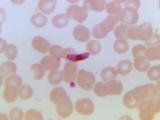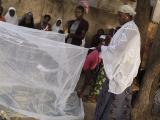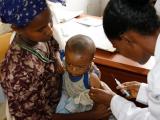In its annual report card on the global battle against malaria, the World Health Organization (WHO) said today that 57 of 106 countries that recorded cases in 2000 have cut new infections by 75% and that 18 more have reduced their burden by 50% to 75%.
When it added up savings from control efforts, the WHO estimates that $900 million in treatment costs have been saved between 2001 and 2014 in its African region, the area hardest hit by malaria. Insecticide-treated mosquito bed nets drove the biggest cost savings, followed by artemisinin-based combination therapies and indoor residual spraying.
Margaret Chan, MD, MPH, the WHO's director-general, said in a statement that malaria investments since 2000 have prevented 6 million deaths. "We know what works. The challenge now is to do even more."
The WHO releases its malaria progress report—an in-depth analysis of trends—each December. Its contributors include a broad range of experts, as well as data from 96 countries and territories that have ongoing malaria transmission and 5 countries that recently eliminated the disease.
Regional highlights
For the first time since the WHO began keeping data, the European region reported no locally acquired malaria cases, which the organization credited to strong country leadership, its technical support, and financial help from the Global Fund to Fight AIDS, Tuberculosis, and Malaria.
Decreases in malaria death rates varied by region, declining by 85% in Southeast Asia, 72% in the Americas, 65% in the western Pacific region, and 64% in the eastern Mediterranean region.
The WHO said its African region still has the highest burden, but over the past 15 years, deaths there have dropped by 66% across all age-groups and 71% in children younger than 5 years.
Global target progress
Overall illness incidence and deaths rates have declined by 37% and 60% respectively, the WHO said. The drop in deaths was even greater (65%) in young children, a group that is especially susceptible to the disease.
The progress has been enough to satisfy a Millennium Development Goal to stop and reverse the global malaria incidence between 2000 and 2015.
The WHO also added that countries have made substantial progress toward the 2005 World Health Assembly goal of a 75% reduction in global malaria burden by 2015.
Steps that made a difference
Low-cost malaria interventions are responsible for much of the progress, the WHO said. For example, it noted that since 2000 more than 1 billion insecticide-treated bed nets have been distributed in sub-Saharan Africa and that by this year, 55% of the population is sleeping under the bed nets, up dramatically from 2% in 2000.
A sharp increase in rapid diagnostic testing has been reported in the WHO's African region, with the percentage of suspected malaria cases being tested rising from 36% in 2005 to 65% in 2014.
The WHO estimates that a trio of control steps, including drug-combo treatment, has prevented 663 million malaria cases in sub-Saharan Africa since 2001.
Remaining challenges
About half of the world's population is still at risk for the disease, the WHO said. And while disease and death rates have fallen, 2015 still saw 214 million new cases and 438,000 deaths from the disease.
Declines are slower in the 15 highest -burden countries in Africa, because of weak health systems, the WHO noted. It added that, as of last year, about a third of the households in the sub -Saharan region still lacked bed nets and indoor residual spraying.
Pedro Alonso, MD, PhD, director of the WHO's Global Malaria Program, said in the statement that new challenges have come, despite the drop in global burden. "In many countries, progress is threatened by the rapid development and spread of mosquito resistance to insecticides. Drug resistance could also jeopardize recent gains in malaria control," he said.
Since 2010, 60 of 78 countries that monitor insecticide resistance have reported mosquito resistance to at least one insecticide used on nets and indoor spraying, and 49 of them reported resistance to two insecticide classes, according to the report.
Malaria parasite resistance to artemisinin, the key component of drug-combo treatment, has been found in five countries in Asia's Greater Mekong region.
See also:
Dec 9 WHO press release
World Malaria Report 2015 home page






















